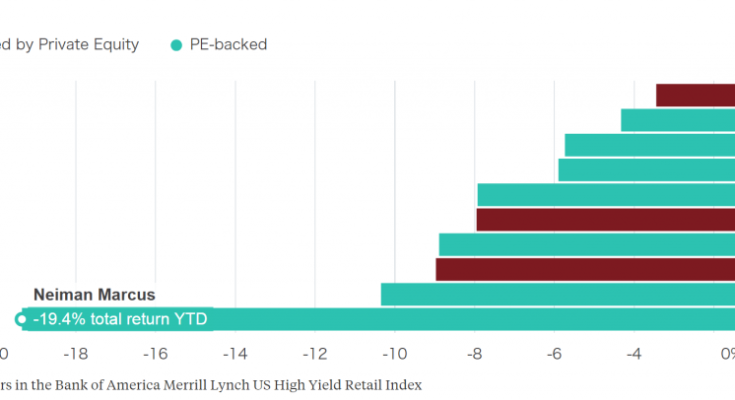Retail Debt Debacles
The retail sector has replaced the oil sector in a sense, and not in a good way. It is the sector that is most likely to see a large surge in bankruptcies this year. Junk bonds issued by retailers are performing dismally, and within the group the bonds of companies that were subject to leveraged buyouts by private equity firms seem to be doing the worst (a function of their outsized debt loads). Here is a chart showing the y-t-d performance of a number of these bonds as of the end of March:

Returns of several of the worst performing junk bonds issued by retailers in Q1 2017. This is rather impressive value destruction for a single quarter – click to enlarge.
Note the stand-out Neiman Marcus, a luxury apparel retailer, the bonds of which have been in free-fall this year. The company was bought out in an LBO and was saddled with a mountain of debt in the process. Investors buying this debt have now come to regret their purchases, particularly as it is debt of the “creative†kind.
Investor demand for junk bonds continues to be brisk, with inflows from retail investors said to be particularly strong. As we have pointed out on previous occasions, this surge in demand has resulted in creditors accepting ever softer loan covenants.
A long period of extremely low interest rates not only leads to a pronounced distortion of relative prices and the associated malinvestment of capital, it also tends to make a growing number of debtors increasingly vulnerable to rising rates and other disruptions. Over time, the number of companies forced to regularly roll over debt if they want to remain among the quick will inevitably increase.
These companies then depend on high investor confidence, which is now faltering in the retail sector. The out look seems appropriately grim: Fitch expects the default rate in the sector to spike to 9% this year.

Yields on junk bonds issued by retailers have begun to diverge rather noticeably from yields on the broader junk bond universe this year – which is reminiscent of oil sector junk bonds in 2014 – click to enlarge.
Ponzi Instruments
One of the innovations created in order to exploit the mindless yield-chasing by investors are so-called PIK toggle bonds (PIK= payment in kind), which essentially represent Ponzi finance instruments.
The term “Ponzi finance†was coined by post-Keynesian economist Hyman Minsky. We think his financial instability hypothesis is descriptive rather than explanatory, but we don’t want to focus on Minsky’s theory. Still, it is at least worth noting in passing that he ultimately argued in favor of even more government intervention, so he basically just recast the old “market failure†fairy tale.

